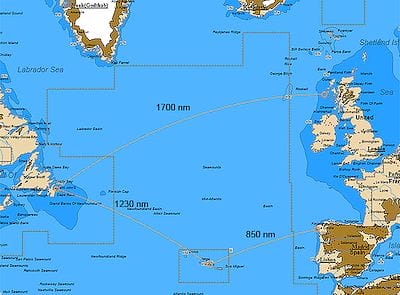Question: We would like to seek your advice on my next summer’s trip from Newfoundland to the Azores, then on to Europe. We left our boat in Newfoundland last year and plan to leave for Europe in June to avoid the hurricane season.

Answer: I have read over your plan and it looks to me like you have thought it all out well. Just a few things that may help:
- I think your plan to leave in late June is good and will allow you to manage the hurricane risk well. Your risk of being overtaken by a hurricane, or extra-tropical storm spawned by a hurricane, would be much higher if you left it until late July or August. If your departure date is delayed for any reason, you should maintain flexibility and not push too hard to get to the Azores, particularly if a bad hurricane season is developing.
- My strategy would be to wait for a cold front to go through and then leave St. John’s immediately after the wind swings into the northwest. This is usually a dry cold wind that will be clear of fog and give you good visibility to transit the area of ice bergs east of Newfoundland. It will also be a fair wind.
- In late June there may be a high concentration of ice bergs on the Grand Banks and so I would plan to heave-to for the hours of darkness for the first 2 to 3 nights. The bright spot is that the nights are very short in June.
If you are delayed until later in the season, the way to manage the hurricane risk is to stay much further north, heading for Scotland. You must even be willing to postpone the whole trip until 2008 if a bad hurricane season develops that prevents you leaving St. John’s with a clear window for the 10 to 12 days you will need to get to Scotland.
The other advantage of the northern route is that if an unexpected hurricane forms in the south you can head due north to get clear of it and stay in the safe semi-circle, or even stop in Greenland or Iceland to let it go past. This route will, of course, expose you to a higher risk of gales and easterly winds, but better that than a hurricane.
To try and manage the risk of headwinds, carefully track the eastbound lows coming off the North American coast and alter course to stay south of the centers so that you stay in westerly winds, even if they reach gale force.
As little as 10 years ago, none of this would have been an issue until well into August, but with the warmer water temperatures in the Atlantic, the windows for safe crossings are getting dramatically smaller at both ends of the hurricane season. I think to be safe we must all learn to be more flexible and alter, or even cancel, our plans to suit the season.

Can you really sail to Scotland from Newfoundland in 10-12 days? Isn’t it about 2000 miles?
Hi Sodrius,
If memory serves it’s closer to 1500 miles from Newfoundland to Scotland, so 12 days should be very doable for a reasonably quick 40 foot boat. My friend Wilson did it single handed in 14 days in a 38 foot boat with a quite short waterline.
Do you feel leaving Newfoundland at the end of June for the Azores is still a good strategy, or do you think warming over the last 15 years has changed the window for sailing this route?
Hi David,
Given the hurricanes that get earlier and earlier every year I would consider moving the target leaving date to early to mid June. The drawback with that is even more ice bergs and fog on the Grand Banks for the first few days after leaving NL, so I might consider leaving from Nova Scotia and staying south of the limit of all know ice, although that will make the trip considerably longer.
The other option would be to go to Bermuda in late May or early June and then leave from there, Benefit is a much warmer trip with no fog. Down side is the possibility of getting caught in Bermuda by an early season hurricane, although said storms do tend to be weaker that early.
The bottom line on all of this is that voyage planning has got much more difficult than it was, because the good windows are a lot shorter. Therefore we need to stay flexible. I would also recommend getting really competent at strategic weather analysis: https://www.morganscloud.com/category/weather/book-weather-analysis/